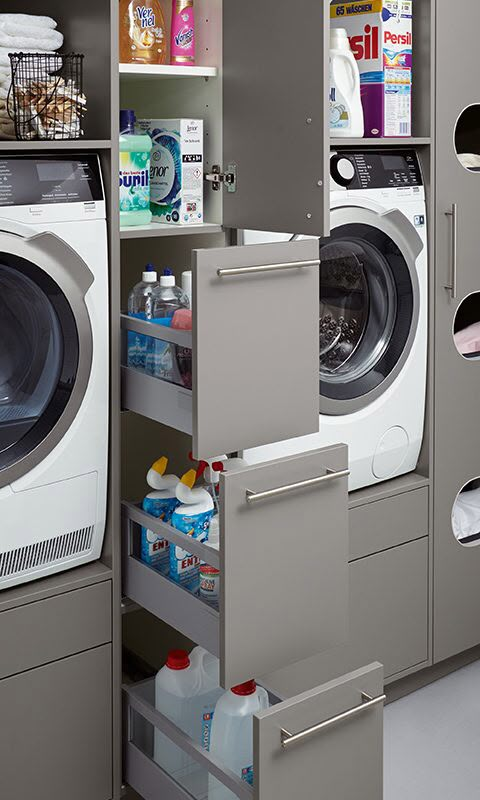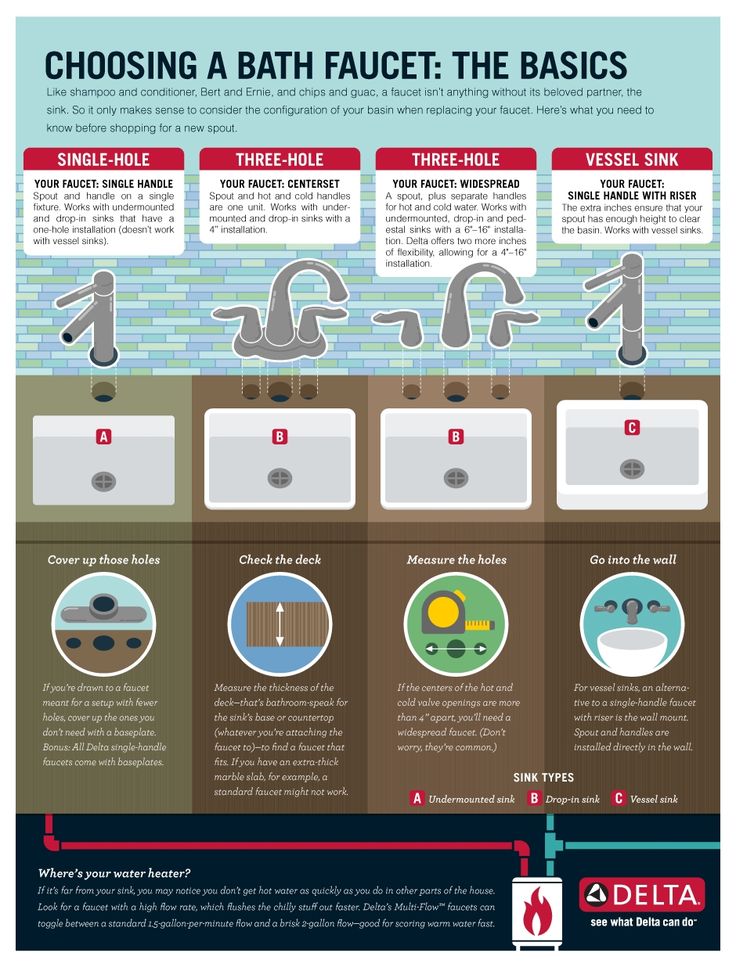How to remove bathtub caulk
The best tricks: How to remove caulk
Before many repairs and installations, you must remove old caulk. A clean surface is essential in keeping those cracks and crevices free of moisture and unsightly buildup. Here’s how to remove caulk and get rid of ugly residue for a fresh start and surfaces that look dazzlingly new.
Caulking windows and other areas can get messy. Learn the best ways to remove caulk and keep it clean.
- How to remove caulk: What to know
- How to remove caulk from a bathtub
- How to remove caulk residue
- Recommended products
How to remove caulk: What to know
Caulking is important for keeping bathrooms, kitchens, and other household areas clean and damage-free. Caulk is used to fill cracks and seal joints around windows, doors, plumbing, siding, and fixtures. This prevents air, water, dust, or other materials from infiltrating seals and keeps things tight.
Good caulking can be the finishing touch that makes a difference between a sloppy fix or a clean, professional installation. We recommend Loctite Polyseamseal Acrylic Caulk with Silicone, a high-quality acrylic caulk formulated with extra silicone for a durable, powerful seal. It sets quickly, is easy to apply, and locks out moisture, air, dirt, or any other penetrating materials.
But with time, even the best caulking can get dingy or lose its seal. Before undertaking many household projects, such as installing new fixtures or tiles, it may be necessary to remove existing caulk. It can be a time-consuming process, but it’s worth doing right.
How to remove caulk from a bathtub
Moisture, soap scum, and other types of build-up are inevitable in bathrooms. To refresh your bathtub’s look, or to prepare for installing a new one, you’ll have to strip away the old caulking. Peeling off that gunky old caulk can be a nasty job, but doing it right will result in a bathtub that looks sparkling fresh. Follow these simple steps for how to remove old caulk from your bathtub.
- Soften the caulk.
 One way to do this is with a commercial caulk remover. The remover will weaken the caulk’s inner structure, making it easier to pry the caulk away. However, caulk removers aren’t necessarily compatible with all materials, so be sure to heed your product manufacturer’s instructions. In these cases, you’ll have to physically remove the caulk.
One way to do this is with a commercial caulk remover. The remover will weaken the caulk’s inner structure, making it easier to pry the caulk away. However, caulk removers aren’t necessarily compatible with all materials, so be sure to heed your product manufacturer’s instructions. In these cases, you’ll have to physically remove the caulk. - Strip the caulk. There are a few methods for doing this. You can use a utility knife or putty knife, slicing through the caulk and peeling it away. For multiple layers of caulk, needle-nosed pliers might work best. There are also specialized caulk removal tools designed to tear away caulk cleanly. The important thing is to exercise care not to dig too deeply and scratch your tub’s surface. And always take extra precautions when using sharp tools. Go slowly, use protective equipment, and be safe!
- Clean the surface. Once the caulk is removed, clean the area thoroughly of any scum or residue.
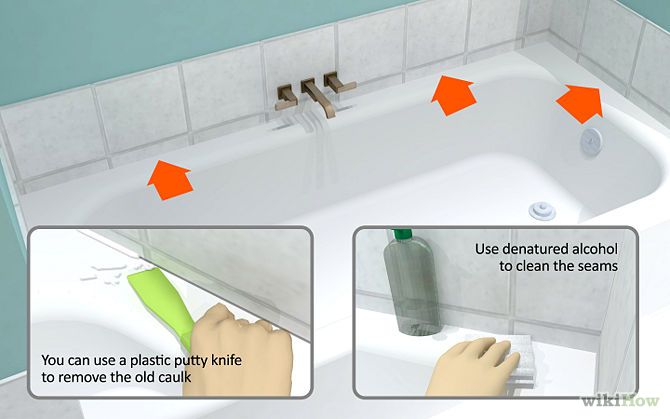 For most surfaces, brush the area with a cloth dampened with bleach, or a non-ammoniated cleaner, to kill mildew. More damage-sensitive substrates may require cleaning with gentler substances such as a denatured alcohol. When using caulk remover, be sure to check manufacturer instructions for details on best materials and methods for cleaning. Let surfaces dry completely before beginning to apply any new caulk.
For most surfaces, brush the area with a cloth dampened with bleach, or a non-ammoniated cleaner, to kill mildew. More damage-sensitive substrates may require cleaning with gentler substances such as a denatured alcohol. When using caulk remover, be sure to check manufacturer instructions for details on best materials and methods for cleaning. Let surfaces dry completely before beginning to apply any new caulk.
For a long-lasting, mildew-resistant seal in kitchens and bathrooms, go for Loctite Polyseamseal Tub & Tile Adhesive Caulk. This versatile, easy-to-use acrylic-based sealant creates a flexible, watertight seal that’s easy to paint or clean, making it perfect for bathtubs, showers, and sinks.
Before repairing or installing sinks and tubs, make sure surfaces are residue- and moisture-free. Silicone caulks, glues, and sealants need dry, clean surfaces for durable seals.
Removing old caulk from a bathtub can be a hassle, but it’s important for clean and fresh new seals.
How to remove caulk residue
Getting rid of old caulk can be challenging. Because caulk is meant to seal tightly and strongly, stripping it off can be a painstaking task, but it’s vital for a clean foundation for your new caulk. On top of all that, removing caulk can leave behind unwanted residue. Here’s how to remove caulk residue.
- Make it soft. Before chiseling away at that caulk residue, soften it as much as possible. For acrylic or latex-based caulk, you can use a commercial caulk remover to loosen the caulk’s bond with the substrate. For silicone caulks, use a liquid remover specifically formulated for use with silicone. For more sensitive materials, or if a caulk remover is unavailable, try mixing a strong powdered cleaner and warm water into a paste, then apply carefully to the caulk with a cotton swab.
For painted, lacquered, or finished surfaces, denatured alcohol may work better than mineral spirits. Caulk remover may also be a good option, but always test solvents on a small, inconspicuous area first before diving in.

Whatever substances you employ, always be sure to wear protective gloves and work in a well-ventilated area. Avoid spills and take appropriate precautions with any flammable materials.
- Clear it off. Start with a cutter knife, slicing the vertical and horizontal flanks of the caulked joint. Once the main triangular portion of the caulk is removed, clean the flanks using a damp abrasive sponge or scrub brush. If stubborn residue refuses to come off, scrape it with a razor blade, but exercise care not to scratch the surface underneath. Avoid using sandpaper, as the caulk will stick to the coarse grit and leave you with a gummy mess. Once the flanks are clean, you can continue with removal of sealant in the joint depths.
If necessary, clean off mold or mildew with warm water mixed with bleach or ammonia-free detergent. Rinse surfaces thoroughly with warm water.
- Caulk away.
 Once the caulk residue is removed and the surface is dry, you’re ready to apply a new caulk. For a tough, strong multipurpose sealant for any job, look for Loctite PL Heavy Duty Sealant. It’s simple to use and creates durable, flexible seals that last a lifetime, both indoors and outdoors. Perfect for tubs and showers, sinks, countertops, tiles, trim, and baseboards, as well as sealing around windows, doors, and siding.
Once the caulk residue is removed and the surface is dry, you’re ready to apply a new caulk. For a tough, strong multipurpose sealant for any job, look for Loctite PL Heavy Duty Sealant. It’s simple to use and creates durable, flexible seals that last a lifetime, both indoors and outdoors. Perfect for tubs and showers, sinks, countertops, tiles, trim, and baseboards, as well as sealing around windows, doors, and siding.
Check out this video to learn more about how to use Loctite PL Heavy Duty Sealant for all your caulking and sealing needs:
Knowing how to remove caulk residue isn’t just about being tidy. Any caulk left on the substrate will prevent new caulk from adhering and may lead to moldy buildup. Do it right now and circumvent problems down the line!
When household fixes gets messy, it’s important to know the best way to remove caulk residue.
Want to get straight to work?
Check out Loctite’s line of powerful sealants for any job here.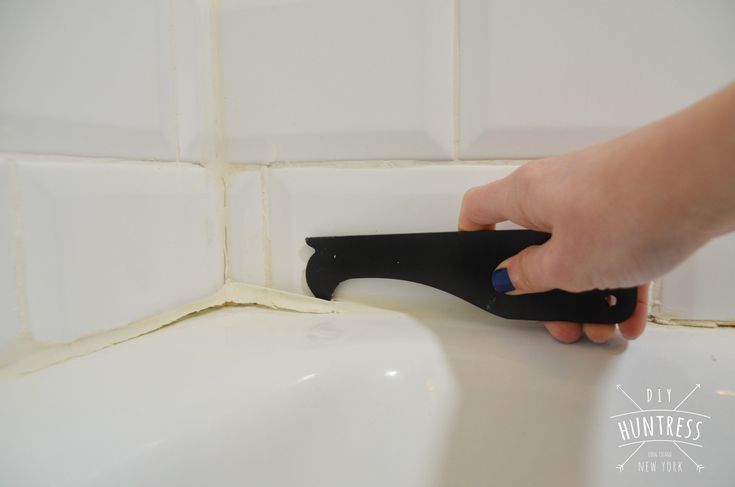
Recommended Products
Back to top
How to Remove Old Caulk From a Tub, Shower, or Sink
By
Bob Formisano
Bob Formisano
Bob Formisano is a licensed architect and builder with nearly 40 years of experience building new homes and restoring older homes. One of his specialties is repairing old systems dating back to the 1920s, including galvanized water pipes, knob-and-tube wiring, and more. His home repair articles for The Spruce span more than 10 years.
Learn more about The Spruce's Editorial Process
Updated on 12/14/22
Reviewed by
Johnathan Brewer
Reviewed by Johnathan Brewer
Johnathan Brewer is a home improvement expert with over two decades of professional experience as a licensed general contractor specializing in kitchen and bath.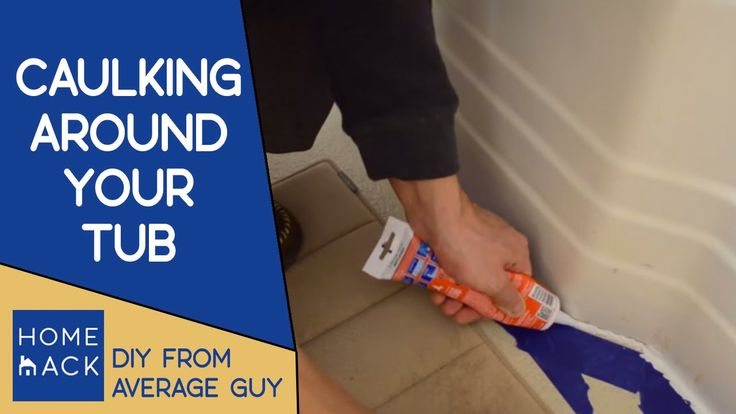 He has been featured on HGTV’s “Super Scapes,” “Curb Appeal the Block,” “Elbow Room,” DIY Network's “House Crashers,” "This Old House," and OWN Network's Emmy award winning show, “Home Made Simple.” Jonathan is also a member of The Spruce Home Improvement Review Board.
He has been featured on HGTV’s “Super Scapes,” “Curb Appeal the Block,” “Elbow Room,” DIY Network's “House Crashers,” "This Old House," and OWN Network's Emmy award winning show, “Home Made Simple.” Jonathan is also a member of The Spruce Home Improvement Review Board.
Learn more about The Spruce's Review Board
Fact checked by
Jessica Wrubel
Fact checked by Jessica Wrubel
Jessica Wrubel has an accomplished background as a writer and copy editor, working for various publications, newspapers and in public libraries assisting with reference, research and special projects. In addition to her journalism experience, she has been educating on health and wellness topics for over 15 years in and outside of the classroom.
Learn more about The Spruce's Editorial Process
The Spruce / Liz Moskowitz
Project Overview
Before applying new caulk around your bathtub, shower, or sink, you must first remove the old caulk.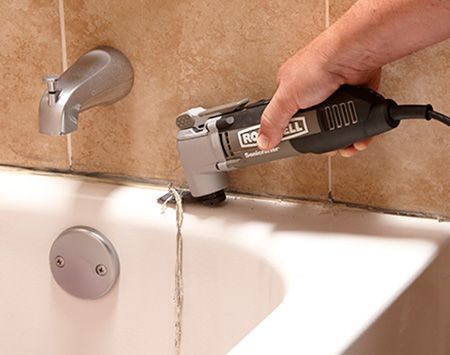 New caulk doesn't stick to old caulk, so if you fail to remove the old stuff, the new caulk can't form a watertight seal, leaving the potential for moisture to seep into areas where you don't want it.
New caulk doesn't stick to old caulk, so if you fail to remove the old stuff, the new caulk can't form a watertight seal, leaving the potential for moisture to seep into areas where you don't want it.
The best way to remove caulk is through a combination of chemical caulk remover and manual tools. Chemical removers require some time to soften the caulk, so if you are in a hurry or don't want to use chemicals, you can also remove the caulk with hand tools alone.
Warning
Always use plastic tools to remove caulking. Otherwise, you may scratch or mar the surface of the fixture.
One easy way to start the process of caulk removal is to use a caulk removal solution, such as the products made by 3M, DAP, and other brands. This chemical remover destroys the bond between the old caulk and the tile, tub, or sink, making it very easy to pry out of cracks and crevices.
A small bottle of liquid caulk remover will remove about 20 linear feet of caulk—enough for most bathtubs. Follow the manufacturer's instructions for use.
Follow the manufacturer's instructions for use.
How to Remove Old Caulk From a Tub, Shower, or Sink
Equipment / Tools
- Plastic putty knife
- Caulk removal tool or razor scraper
Materials
- Chemical caulk remover
- Rubbing alcohol
- Cloths
The Spruce / Liz Moskowitz
-
Apply the Chemical Caulk Remover and Let Sit
Squeeze chemical remover onto the old caulk bead, so the caulk is covered completely.
Let the caulk remover sit on the caulk as directed by the manufacturer's instructions. Some users report that it helps to allow the product to set overnight for maximum effectiveness.
The Spruce / Liz Moskowitz
-
Scrape Away the Caulk
Use a plastic putty knife or other tools to scrape away the old caulk. If possible, try to peel it off in strips as you scrape.
Inspect the area thoroughly, and remove any remaining caulk residue with the tool.
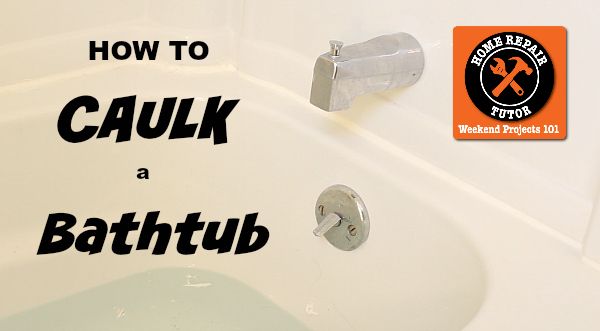 A caulk removal tool or razor scraper can be useful at this point. To clean up the old caulk remnants, use a shop vac to thoroughly pick up any debris.
A caulk removal tool or razor scraper can be useful at this point. To clean up the old caulk remnants, use a shop vac to thoroughly pick up any debris. The Spruce / Liz Moskowitz
-
Clean the Surfaces
Clean the surfaces thoroughly with a clean cloth moistened with rubbing alcohol. The cleaner the area, the easier it will be for the new caulk to bond properly. Let the surfaces dry completely before applying new caulk.
The Spruce / Liz Moskowitz
Caulk Removal Tool
Several manufacturers make caulk removal tools, which sometimes come in kits that include tools for applying and smoothing new caulk. The better tools are made of plastic or polished steel that won't scratch surfaces and have angles and blades designed to scrape caulk out of narrow crevices and corners. One excellent tool from Hyde has a corner scraper blade that is reversible and replaceable to ensure you always have a sharp tool.
Caulk removal tools can be used by themselves, but they are also great as the second step after applying chemical caulk remover.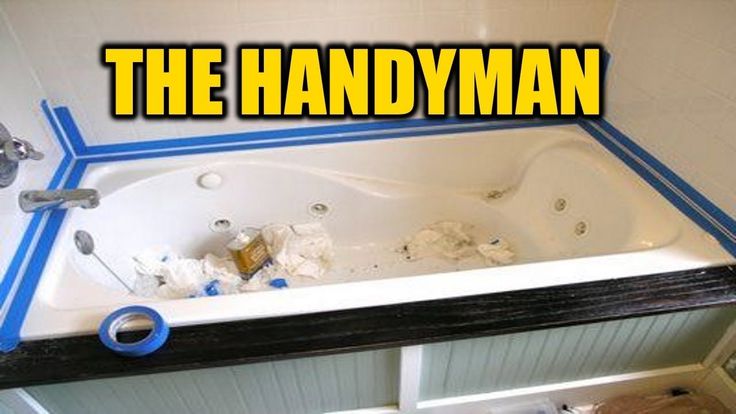
Razor Scraper
Another tool that works well is a good old-fashioned razor scraper. The trick here is to use a very sharp blade and to make sure the blade edge is flat on the surface to prevent scratching. A razor is ideal for getting behind thin smears of old caulk.
In general, it is best to scrape behind both side edges of the caulk bead to separate it from the surface, then try to peel it off in long strips. To prevent scratching, be careful not to let the corners of the blade contact the surface. Keep the tool at a low angle—almost flat to the surface—at all times. Acrylic and fiberglass surfaces are especially susceptible to scratching.
How to remove silicone sealant from a bathtub, 4 cleaning tips from the pros
Removing silicone sealant from a bathtub without damaging it is not so easy, because the material has good adhesion to various surfaces and is quite difficult to remove.
Silicone Sealant is available as one-component and two-component. Its main property is due to resistance to various aggressive environmental influences. Silicone is widely used in construction, not only indoors, but also outdoors. nine0003
Its main property is due to resistance to various aggressive environmental influences. Silicone is widely used in construction, not only indoors, but also outdoors. nine0003
Content
- 4 Pro Tips
How to remove sealant from a bathtub
There is no one-size-fits-all solution for removing sealant from any surface. To erase it, it is necessary to use chemical and mechanical methods of exposure. It is difficult to remove old sealant that has dried and stuck to the tub. In the liquid state, the material is removed more easily. It is enough to rub the soiled surface with a sponge moistened with alcohol or gasoline. nine0003
Removal methods depend on the material from which it is removed. For cast iron, acrylic or steel baths, solutions are used that do not harm the surface.
Special silicone thinners are commercially available, but they are unable to completely remove heavy build-up. This is where mechanical action is required. Solvents only soften the thick layer of sealant, making it easier to remove.
Solvents only soften the thick layer of sealant, making it easier to remove.
A universal silicone cleaner is available from car dealerships. It is effective on smooth surfaces such as ceramics and glass. You can also use acetone. When using it, it is important to remember the precautions. nine0003
Only by using combined cleaning methods can the desired effect be achieved.
The specifics of cleaning silicone
The sequence of actions and the choice of means for removing silicone from the bath depend on the material from which it is made. So, the acrylic bath can be washed only with the help of special tools. Otherwise, there is a risk of deformation and damage to the product. Do not use on acrylic surfaces:
- powders and abrasives;
- metal scrapers, knives, blades;
- solvents based on acetone, alcohol, benzene and petrol.
To remove the old silicone sealant from the acrylic bath, you need to use ready-made compounds sold in stores. The cleaning agent is applied to the surface and left for 24 hours. Then remove with a wooden spatula. The surface is washed, wiped dry and degreased.
The cleaning agent is applied to the surface and left for 24 hours. Then remove with a wooden spatula. The surface is washed, wiped dry and degreased.
The specificity of removing silicone sealant from cast iron and steel bathtubs differs in that permitted chemicals and more rough mechanical methods of action can be used. But working with enameled baths also has its own peculiarities. When cleaning the surface, it is not recommended to apply strong physical efforts. This can damage the top layers of the bathtub. nine0003
Chemical Methods
The industry produces specialty chemicals to remove sealant from various surfaces. They are selected taking into account the material for the manufacture of the bath and the resistance to chemical attack of the tile. Chemicals will help to remove the sealant from the bathroom quickly, but they must be used with caution.
Old thick silicone can be removed with mineral spirits. The solvent will soften the silicone compound.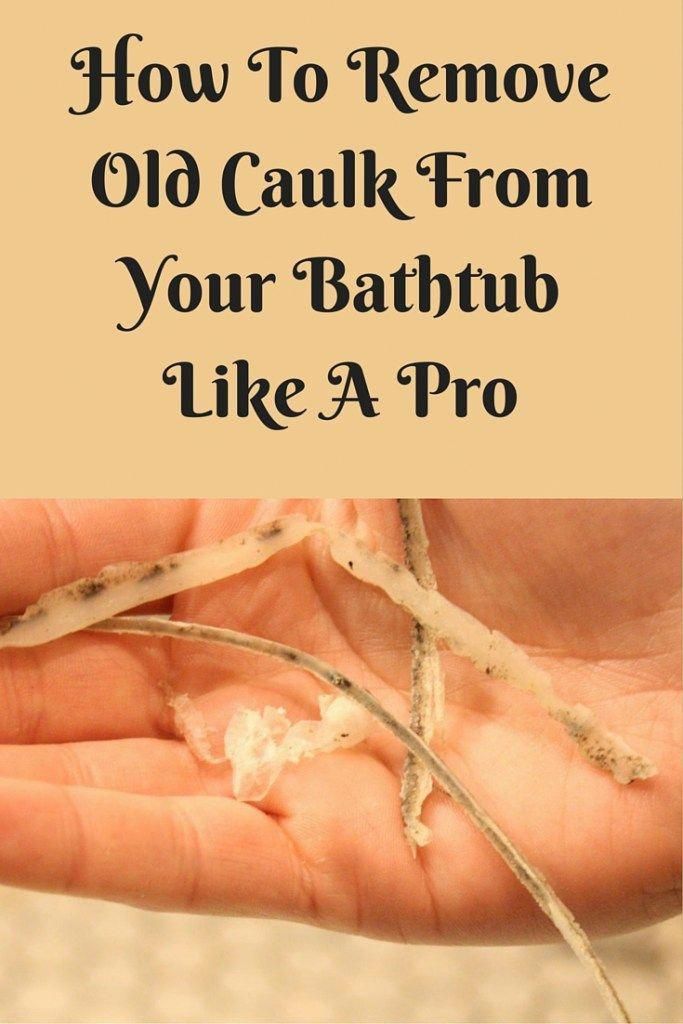 The sealant will be easier to remove and wipe off the tub. The application of white spirit takes some time, because the liquid must be absorbed and a chemical reaction begins. The cleaning process takes 3-4 hours. nine0003
The sealant will be easier to remove and wipe off the tub. The application of white spirit takes some time, because the liquid must be absorbed and a chemical reaction begins. The cleaning process takes 3-4 hours. nine0003
The bath can be cleaned using chemicals containing methylsiloxane components. Such solvents quickly soften the bonds between the surface and the sealants. With their help, they achieve good results.
All chemicals are aggressive and can harm human health, so it is important to follow safety measures when working with them.
Precautions
When using chemical solvents and other special formulations for cleaning, it is important to ensure a safe working environment. Consider the following:
- the room must be well ventilated;
- only work with rubber gloves and a protective mask;
- do not use chemicals near the fire, smoking during work;
- the manufacturer's instructions for handling the agent must be strictly followed;
- Thoroughly wash hands with soap and water after finishing work.
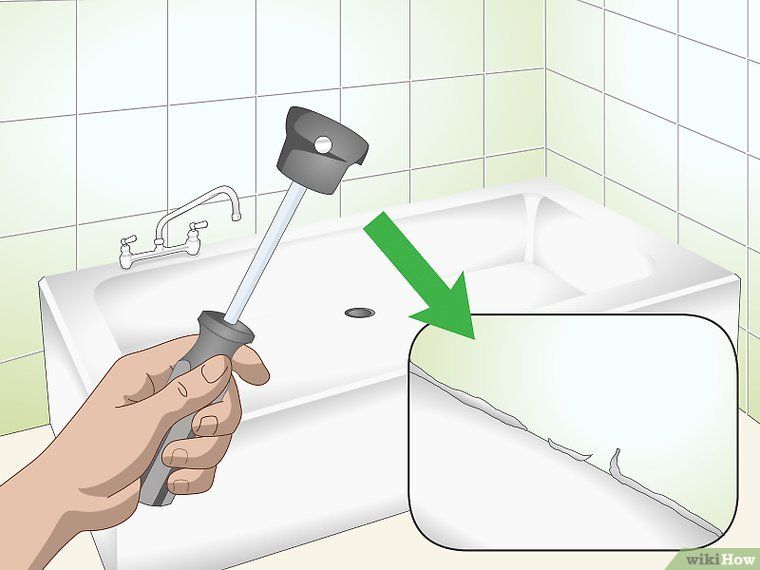
Caution is also important when working with sharp piercing and cutting objects. After all, in order to clean the product from the sealant, you often have to use blades or knives. They are necessary to remove the top layer of silicone. nine0003
Mechanical methods
Mechanical methods mean physical impact. The removal of silicone sealant begins with a mechanical method. Before using special products, you need to rub the substance or, if necessary, cut off the top layer. Abrasives are suitable for mechanical removal.
The use of table salt for these purposes is a popular and fairly safe way. To remove minor stains, pour a small amount of fine table salt moistened with water into gauze and rub the stain with it. Then we wash the surface with running water. nine0003
Tools to help
Various tools available to remove the sealant from the bath, such as a spatula, utility knife or blade, pumice, brushes with stiff bristles, etc.
with a sponge and textile napkins. They also apply a solvent.
Pro Tips
Expert Tips:
- Before using a chemical, apply it to a small and inconspicuous area of the tub and monitor the reaction of the material to the chemicals. In this way, damage to the product can be avoided. nine0016
- When working with sealant, it is advisable to wipe off drips and drips before it hardens.
- Silicone substances have a destructive effect on products made of polyacrylate, polycarbonate. In this regard, they are not prohibited from combining.
- Always follow the rules for working with chemicals.
With the right approach to the procedure, it will not be difficult to remove the sealant from the bath.
Bath & Toilet Cleaning
Like this article? Share with friends:
How to remove, how to remove the sealant from the bath and how to properly use the sealant
Very often, to ensure the tightness of the connection between the bath and adjacent surfaces, a sealant is used, which allows the joint to be completely watertight. However, over time, this material is destroyed and then the question arises of how to remove the sealant from the bath in such a way as not to damage the surface. In this article, we will tell you how to replace the old sealant and attach a video material that will show the procedure clearly. nine0003
However, over time, this material is destroyed and then the question arises of how to remove the sealant from the bath in such a way as not to damage the surface. In this article, we will tell you how to replace the old sealant and attach a video material that will show the procedure clearly. nine0003
The question of how to remove the sealant from the bath arises in two cases, during the repair of the surface of the font or for the planned replacement of the layer due to a leak. If the applied layer is thick enough, then you can cut it a little with a special construction knife and remove it without problems. But if the sealant between the bathroom and the wall has a thin layer, then you can’t do without special tools.
Note. If the sealant has lagged behind the bath in some places or it has been applied relatively recently, then it can even be removed by hand, and the remaining parts can simply be rolled up with a finger or a rag. But if the stand is already old and hardened to a stone state, then it cannot be rolled up with your hands, and the use of a knife can damage neighboring surfaces.
nine0003
- How to remove a layer of sealant
- Mechanical removal
- Chemical removal
- How to apply sealant to bathroom joints
How to remove the sealant layer
Silicone Bathtub Sealant
Today, there are two main ways to remove the sealant at the joints in the bathroom:
- mechanical, when the removal process is carried out using various tools; nine0016
- chemical, when chemical agents are used for removal that break down the structure of the sealant and allow it to be easily removed without damaging adjacent surfaces.
Important. Before cleaning the sealant from the bathtub with chemicals, make sure that the chemicals will only affect the sealant itself and will not harm other adjacent coatings in any way. As a rule, if the chemical is specifically designed to remove silicone, then it cannot damage any other materials, but if you use another product, then carefully read the instructions before removing the sealant from the bath.
nine0003
Mechanical removal method
Mechanical silicone scraper
For mechanical removal, it is best to use a regular utility knife with a retractable blade. It is important that the blade is sharp, as a dull blade can damage the surface of the tub or tile. Before tearing off the sealant, it is advisable to wear safety glasses, since the blade of such knives can fly off in any direction when broken.
Then extend the knife blade to a length that is approximately equal to the thickness of the sealant layer and cut the seam exactly in the center. If the layer is very hardened, then this action can be repeated several times to achieve the desired depth of cut. Sealant removal will be faster if the depth of the cut reaches the base of the material on which the seam is held. After the central cut is ready, position the blade parallel to the surface of the tub and make the same cut to the base. Then repeat the cutting process, but from the side of the wall. nine0003
nine0003
Advertising
After the performed operations, the sealed seam can be removed by hand, but there will most likely be its remnants on the surfaces. How to clean the sealant from the bath in this case? You can use the same knife or a regular blade, applying it tightly to the surface to be cleaned. In this case, experts recommend working with a blade, since its material is much softer and allows you not to scratch the surface of the bath.
Chemical removal
Chemical removers for old silicone
Removal and replacement of sealant using modern chemicals is much easier and safer, and in many cases takes much less time than the mechanical method. First you need to find out how to dissolve the sealant and what tools are best used for this. To date, special solvents are considered the best means, such as:
- Logatto;
- CRC Gasket Remover;
- Quilosa;
- Dow Corning OS-2; nine0016
- Penta-840;
- White spirit.
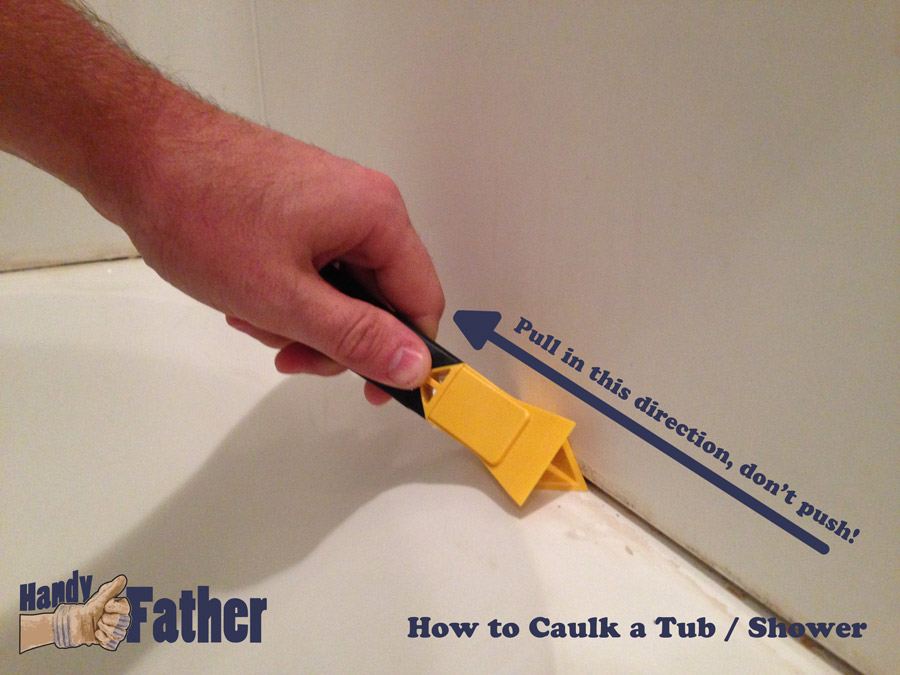
Note. Before washing the sealant from the bath, you need to consider the composition of the bath itself. For example, paste-like and emulsion preparations with abrasive materials cannot be used on acrylic hot tubs, as they will damage the surface. In such cases, liquids or aerosols must be used. Also, before using the drug, be sure to check the reaction of the bath coating.
The above-mentioned foreign-made drugs are more expensive than domestic ones, but their effectiveness is an order of magnitude higher. Domestic white spirit is just as effective, besides, you will have to use it before gluing the bathtub with a sealant to degrease the surface. nine0003
The bottom line is this, before wiping off the sealant, apply the product to the seam and leave for 15-20 minutes. During this time, the structure of the sealant is destroyed and it becomes soft, after which you remove it with a wooden scraper or rag.
How to apply sealant to bathroom joints
Installation of protective tape on the joint
The question of how to coat the bathtub with sealant so that it looks beautiful is rather complicated. The very procedure for using this material does not require any special skills, if the junction is not visible or it is closed with a plastic corner. But not everyone knows how to cover a bathtub with an open seam sealant. In order to avoid mistakes and not spoil the elements of the room, we recommend that you strictly follow the instructions below and then sealing the seams in the bathroom with a sealant will go without a hitch. nine0003
The very procedure for using this material does not require any special skills, if the junction is not visible or it is closed with a plastic corner. But not everyone knows how to cover a bathtub with an open seam sealant. In order to avoid mistakes and not spoil the elements of the room, we recommend that you strictly follow the instructions below and then sealing the seams in the bathroom with a sealant will go without a hitch. nine0003
For work, prepare a tool such as:
- caulk gun:
- dry and clean rags;
- hair dryer, normal hair dryer;
- masking tape;
- White spirit.
Next, before sealing the bathtub, study and follow the instructions in detail.
Applying a layer of sealant
- Surface preparation. Applying sealant will be a waste of time if the surface is not prepared. In the presence of dust or grease, the material will not stick and the joint will not be watertight. Wipe the joint with white spirit, then dry it well with a hair dryer, as the silicone will not stick to a wet surface.
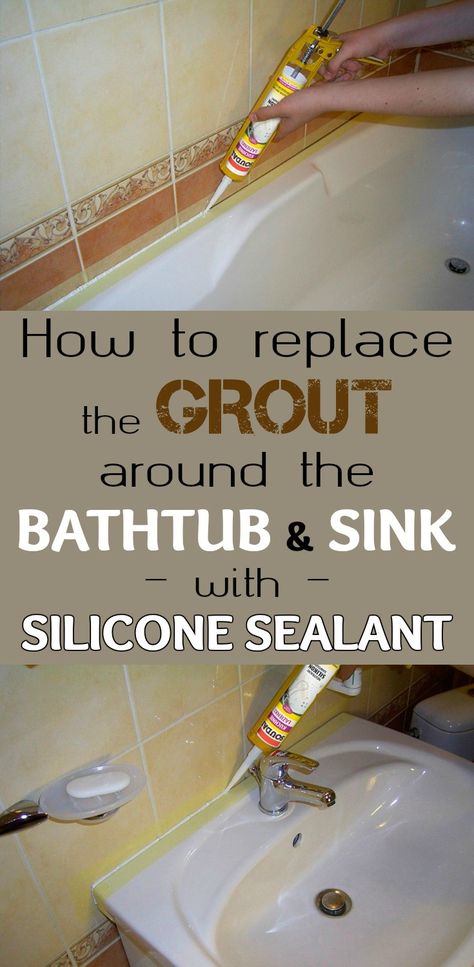 nine0016
nine0016 - Surface protection. Before applying the sealant in the bathroom, you need to glue masking tape along the entire joint at a short distance from the seam itself. This is done so that thin and imperceptible excess sealant does not remain, which then begins to peel off and ruin the whole appearance. Try, before using the sealant, to paste over the adhesive tape as evenly as possible, since it is he who sets all the beauty of the seam.
- Application of sealant. Standard products are made in the form of tubes with plastic spouts that are inserted into a metal gun for ease of use. Before applying the sealant, we cut off the nozzle according to the required layer width, insert the tube into the gun and evenly apply a layer to the joint, trying to immerse the composition as deep as possible deep into the joint. nine0016
- smoothing. After sealing the bath with sealant around the entire perimeter, you need to smooth the seam. To do this, simply wet your finger and run it along the seam, removing excess.



